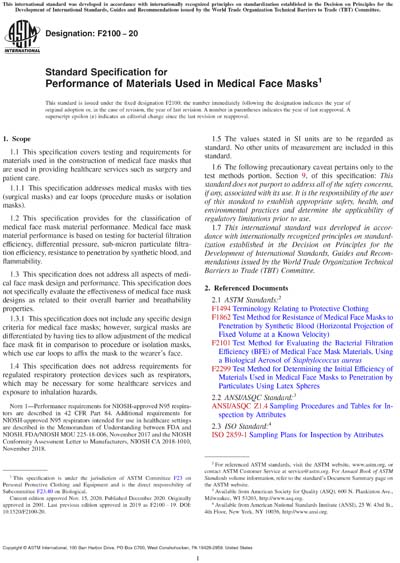Historical
ASTM F2100-20
Standard Specification for Performance of Materials Used in Medical Face Masks
1.1 This specification covers testing and requirements for materials used in the construction of medical face masks that are used in providing healthcare services such as surgery and patient care.
1.1.1 This specification addresses medical masks with ties (surgical masks) and ear loops (procedure masks or isolation masks).
1.2 This specification provides for the classification of medical face mask material performance. Medical face mask material performance is based on testing for bacterial filtration efficiency, differential pressure, sub-micron particulate filtration efficiency, resistance to penetration by synthetic blood, and flammability.
1.3 This specification does not address all aspects of medical face mask design and performance. This specification does not specifically evaluate the effectiveness of medical face mask designs as related to their overall barrier and breathability properties.
1.3.1 This specification does not include any specific design criteria for medical face masks; however, surgical masks are differentiated by having ties to allow adjustment of the medical face mask fit in comparison to procedure or isolation masks, which use ear loops to affix the mask to the wearerâ's face.
1.4 This specification does not address requirements for regulated respiratory protection devices such as respirators, which may be necessary for some healthcare services and exposure to inhalation hazards.
Note 1: Performance requirements for NIOSH-approved N95 respirators are described in 42 CFR Part 84. Additional requirements for NIOSH-approved N95 respirators intended for use in healthcare settings are described in the Memorandum of Understanding between FDA and NIOSH. FDA/NIOSH MOU 225-18-006, November 2017 and the NIOSH Conformity Assessment Letter to Manufacturers, NIOSH CA 2018-1010, November 2018.
1.5 The values stated in SI units are to be regarded as standard. No other units of measurement are included in this standard.
1.6 The following precautionary caveat pertains only to the test methods portion, Section 9, of this specification: This standard does not purport to address all of the safety concerns, if any, associated with its use. It is the responsibility of the user of this standard to establish appropriate safety, health, and environmental practices and determine the applicability of regulatory limitations prior to use.
1.7 This international standard was developed in accordance with internationally recognized principles on standardization established in the Decision on Principles for the Development of International Standards, Guides and Recommendations issued by the World Trade Organization Technical Barriers to Trade (TBT) Committee.
Content Provider
ASTM International [astm]






